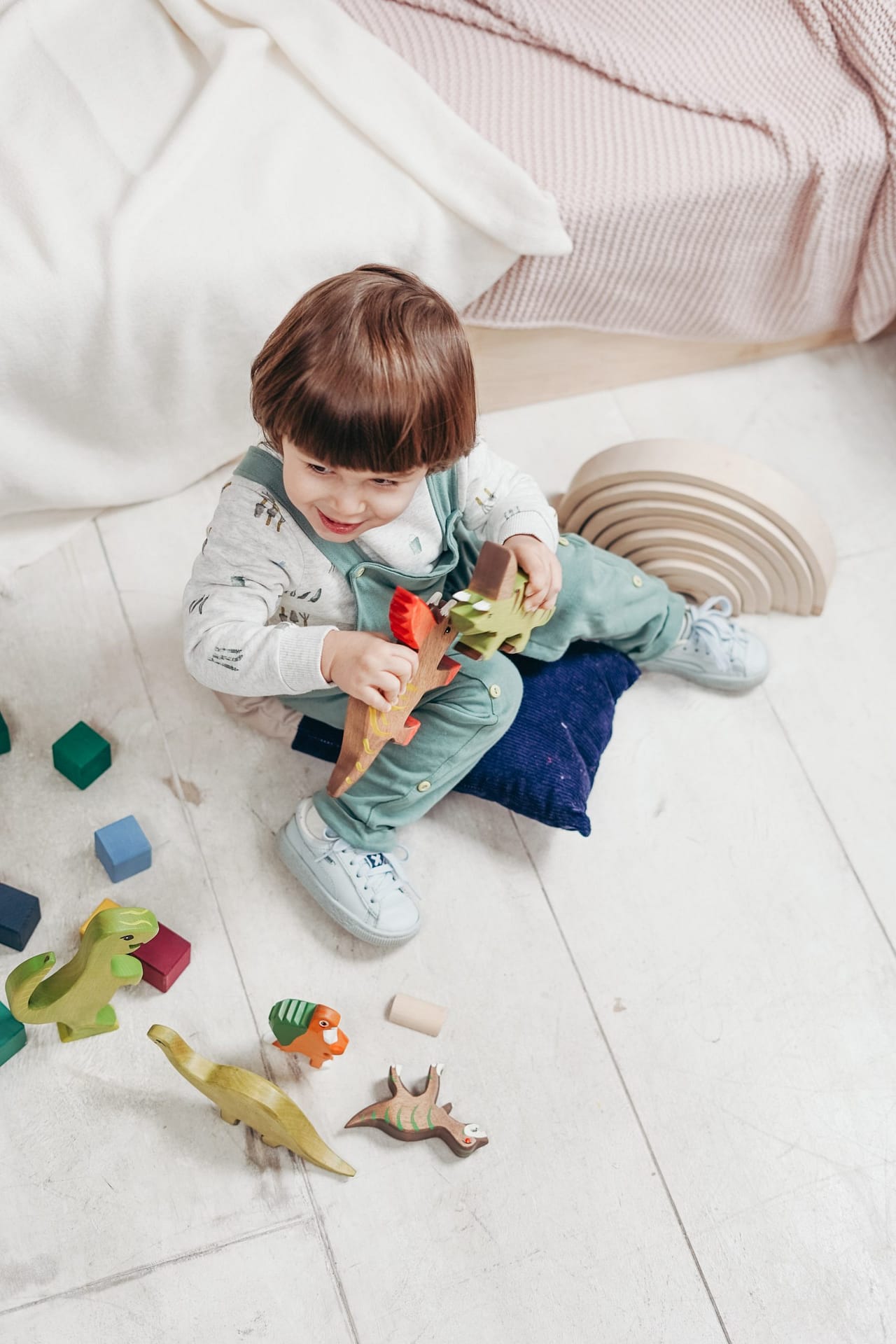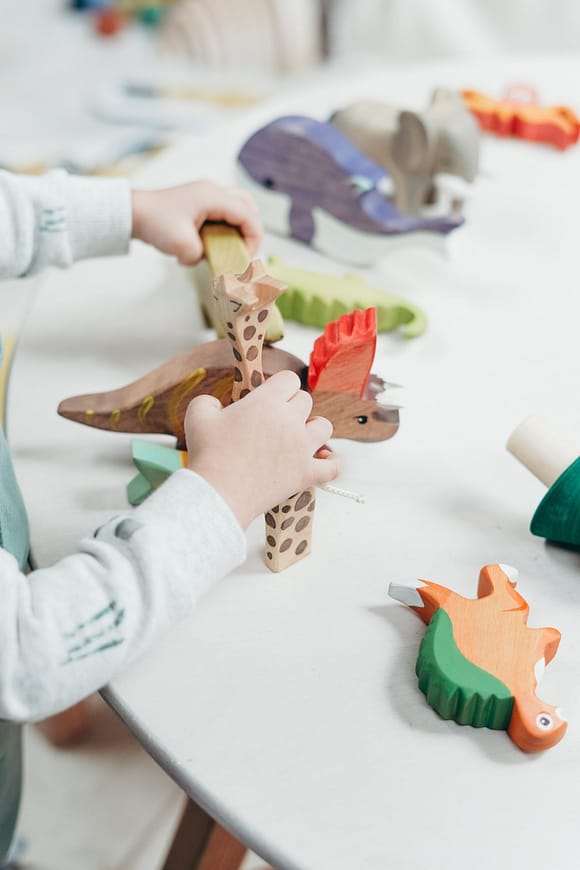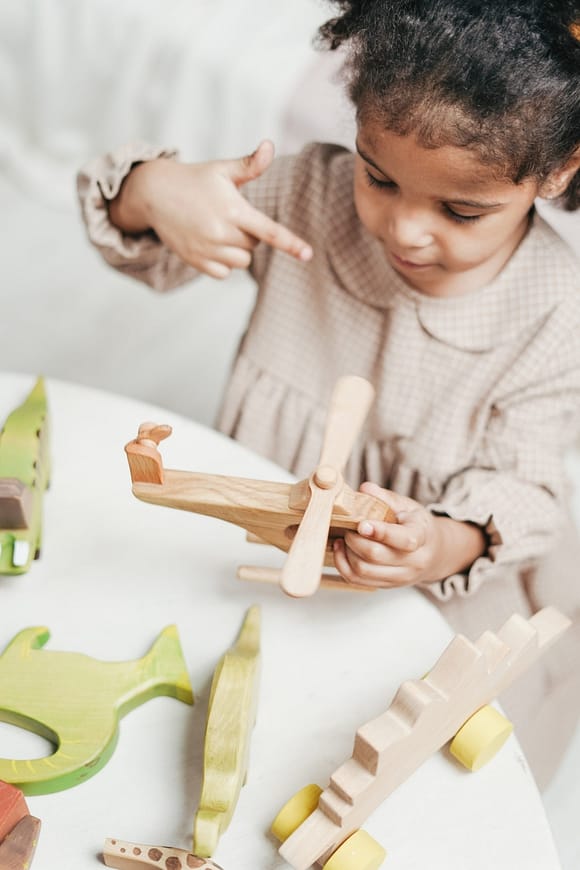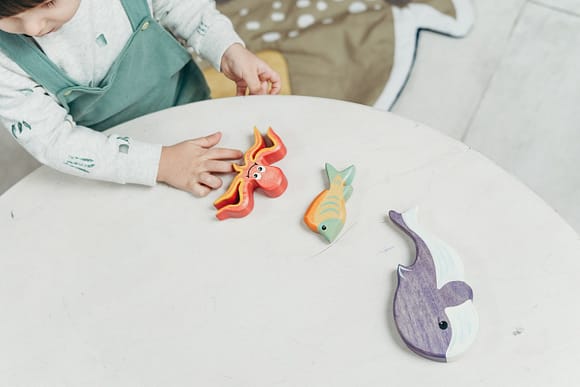Have you ever thought, “Jesus, I’m tired. Do I *always* have to play with my child?”
(always as in, almost every moment of your day, every time they ask, always)
Don’t get me wrong…
Playing with our children is a beautiful way to connect with them.
We should do it as often as we can – but we must also guide them to learn how to play independently.
This is called independent play.
From babies to children to adults and parents, having time alone to think and explore and create is a valuable form of play.
And as parents, time “alone” (being physically present while your children are playing independently) is crucial for being a healthy parent.
That’s time to sneak a snack, do some yoga, or check some email.
Maybe take a good poop with the door closed.
If you want to learn whether or not you have to play with your toddler all day, every day (newsflash: nope!), keep reading.
You’ll also learn 7 things you can do to help your child learn to love independent play.
*This post may contain affiliate links, which means I may receive a small commission, at no cost to you, if you make a purchase through a link. And as an Amazon Associate, I earn from qualifying purchases.
Do you have to entertain your toddler all day?
No, you do not have to entertain your toddler all day. I said ~ all ~ day!
You don’t need to feel guilty about it either.
Playing with our children is one of our duties as parents, and playing is an excellent way to bond.
But, that does not mean you have to be engaged together every moment your precious tiny tot is awake.
It is simply impossible and truly exhausting to try to do.
Children are experts at exploring, imagining, and dilly-dallying.
Learn to take a backseat to your child’s playtime, whether they are a baby or a wild, free-roaming tot.
Continue being committed to having those traditional down-on-the-rug play sessions, but also commit to giving your child the reins when it comes to their play.
It’s time well spent for both of you.
What is independent play?
Independent play is when your child plays alone with nearby supervision.
The child chooses what to play with and how to play.
This could be playing with cars or stacking blocks to lying on the couch with their feet in the air, eyes locked on the popcorn ceiling.
Does playing with the couch pillow tassels count? Sure it does.
Parents may designate 5-45 minutes or even hours of independent playtime.
Still, the child’s age depends on how much independent playtime they can tolerate.
Since we’re talking about toddlers, toddlers can play by themselves for about 30 minutes, though they’ll need to learn how to do this with help from you.
Start small with 5-10 minutes, then gradually increase.
45 minutes is the sweet spot where children start tapping deep into their imaginations, so aim for that as your child gets used to playing by themself.
How can I encourage independent play?
If you don’t want to entertain your toddler all day, you’ll need to teach them how to play by themselves.
Even though the need for independent play is naturally inside every kid, yours may not like it at first.
Start small and take baby steps (no pun intended…) using these 7 tips for encouraging your toddler to play independently.
1. Create a “Yes” space that your child feels comfortable exploring
Children need space to play where they are safe.
While keeping your child physically safe is a no-brainer, I mean this in the sense that your child needs to feel safe in the play space.
Ideally, nothing in the play space should be off-limits.
Heard of “Yes” spaces?
You might have if you’re an RIE or Montessori follower.
To create a “yes” space, set out ” allowed ” toys that won’t drive you bonkers with noise, and safely cover or put away cords, plugs, outlets, etc.
This way, your toddler will be confident as they explore since you won’t be checking in with “What are you doing?! No!”
Early Childhood educator and infant expert Magda Gerber advocated for what she called a “Yes” space for children because she knew it provided safety for the child and peace of mind for the parents.
She understood that a “Yes” space helps flourish confidence in children.
In a “Yes” space, the only things in that space should be things the child is 100% allowed to explore and touch.
Age-appropriate toys and books work best and steer clear of messy activities like paint and Kinetic Sand.
Think about your child’s height and ensure that everything can be easily reached.
2. Tell your child where they can find you
Before sending them off to play, tell your toddler where they can find you if they need you.
This helps them feel more secure and safe.
For example, I’d say to Wade, “I am going to do the dishes in the kitchen.”
3. Tell your child what you expect them to do
When you explain to your child where you’ll be, tell them what you expect them to do.
Establishing the expectation gives them clear direction and also helps them feel safe and secure.
- “While I’m in the kitchen, I would like you to play by yourself in the living room.”
- “Now it’s independent play time.”
- “It’s time to go play by yourself. Would you like to listen to music while you play?”
Wade is 4, so he has been able to play comfortably by himself for a few years now.
It used to be (what felt like) every second of the day; he would ask if I could play with him.
While I usually said yes, I could, anger would bubble up inside me because I ignored all of my other duties for the umpteenth time.
So, now I know to explain what I’ll be doing and what I would like him to do.
It’s become routine for him to play independently now, so he usually wanders off with no problem when I tell him that.
4. Use a timer
Timers are a great tool because it teaches children the concept of time and provides a reference point for when their play session will end.
This could be a timer on your phone or a kitchen or sand timer.
Wade likes using the timer on Alexa because he can do it himself.
Use a visual timer if possible since toddlers can’t tell time yet!
5. Let boredom be
Our society frowns upon “being bored.”
Some equate being bored to being lazy.
We think if our children are not engaged in some activity or learning their ABCs, they are bored and must not be learning anything.
But it should be quite the opposite!
Let your child sit with their thoughts.
Let them be bored!
And if you have a baby, let them comfortably “hang out” in their seat, on their blanket, wherever.
We forget that everything is so new to our sweet babies, so sometimes we may think they need to be constantly bounced, talked to, or played with.
Again, while all of those things are wonderful ways to connect with your child, don’t exhaust yourself thinking you have to be an entertainer 24/7.
6. Be present but engaged when prompted
One of the best things we can do to encourage our children to play independently is to allow them to stay in their train of thought.
So be semi-picky with when you interact with your child during their independent play time.
They may be talking, but try your best to refrain from making comments unless they come up to you or lock eyes.
You know, if they need you.
But when your child is content and playing, listen to them.
Observe them.
I find this to be surprisingly challenging.
It’s hard to shut up sometimes as a mom!
- “Are you having fun?”
- “That’s a beautiful picture!”
- “What a tall tower you built!”
- “Yaaaay!”
Can you picture yourself doing this?
If you’ve ever been hyper-focused on a project, you know how wrenching it can be to be stopped mid-thought.
So refrain from commenting and wait until your child presents you with a picture/toy or wait until you see them looking at you, waiting for you to engage.
We help train their brain to focus for more extended periods by letting them be.
You’re essentially saying,
“I trust you to choose what you want to do. You are capable. I am always here if you need me.”
Save your breath, save your energy, and wait for your child to actively engage you.
7. Be flexible
But what if your child comes up to you and asks you to roll the car?
Now is your time to be engaged but still passive during this play.
Be flexible, at least at first.
Ask your child what they would like you to do.
“You would like me to help? Okay, what would you like me to do?”
Let them show you or explain, then say it back to them.
“So you want me to play with that doll?”
Be flexible in that you could have your hand on the doll.
The doll could also be sitting next to you while working at your computer.
To take it further, say your daughter asks you to feed the doll.
You could say, “She can sit right next to me here, but I don’t want to feed her. ”
This gives you some part in their play but still supports your child to springboard back into choosing what she wants to do next.
Benefits of independent play for toddlers
Oodles of awesome things happen inside a child when they engage in independent play.
During independent play, toddlers:
- flex their creativity
- learn to problem-solve
- increase their confidence
- practice self-regulating their feelings and behavior
Watch as your child moves from one task to another, choosing what catches her interest, and see how they cope when a toy becomes stuck or out of reach.
Will she try to figure it out on her own?
Run to you for help?
Choose to move on to another toy?
Whatever they decide, you’ll be there if they need you – feet or a room away.
She can trust you to be there for her, which strengthens the bond between you, too.
So remember:
self-directed, independent play is an excellent way for your toddler to build up essential skills like problem-solving and self-regulation.
Your takeaway
While you may feel like you have to entertain your toddler all the time, the truth is you don’t.
Enjoy the time you do spend together.
When you’re not available to play, help them learn how to love independent play.
Tell them what you’d like them to do and for how long, and put a visual timer where your child can see it.
Resist the urge to add commentary, though be flexible and respond to your child if they engage with you a little while playing.
Lastly, remind them where you’ll be if they need you.
Doing these 7 things helps nourish your child’s innate desire for self-directed play.
Enjoy the break!
Or at least get a little more work done.
So, what tip can you add to this list?
Spill your secrets!








